Basic Information
-
mRNA and protein expression analysis

-


RT-PCR and western blot analysis of GLP1R. The mRNA of human GLP1R was detectable in the lung of the homozygous B-hGLP1R mice, but not detectable in wildtype mice. and we proved that the protein could be expressed normally by western blot analysis. Human and mouse cross-reactive antibodies were used to detect the GLP1R of the wildtype and humanized GLP1R mice.
-
Protein expression analysis

-

IHC for human GLP1R expression. Pancreata from wild-type (+/+) and B-hGLP1R mice (H/H) mice were stained using an antibody specific for human GLP1R. and only the pancreas from B-hGLP1R mice (H/H) mice showed hGLP1R positive signal in plasma membrane.
-
In vivo efficacy of Dulaglutide in B-hGLP1R mice

-
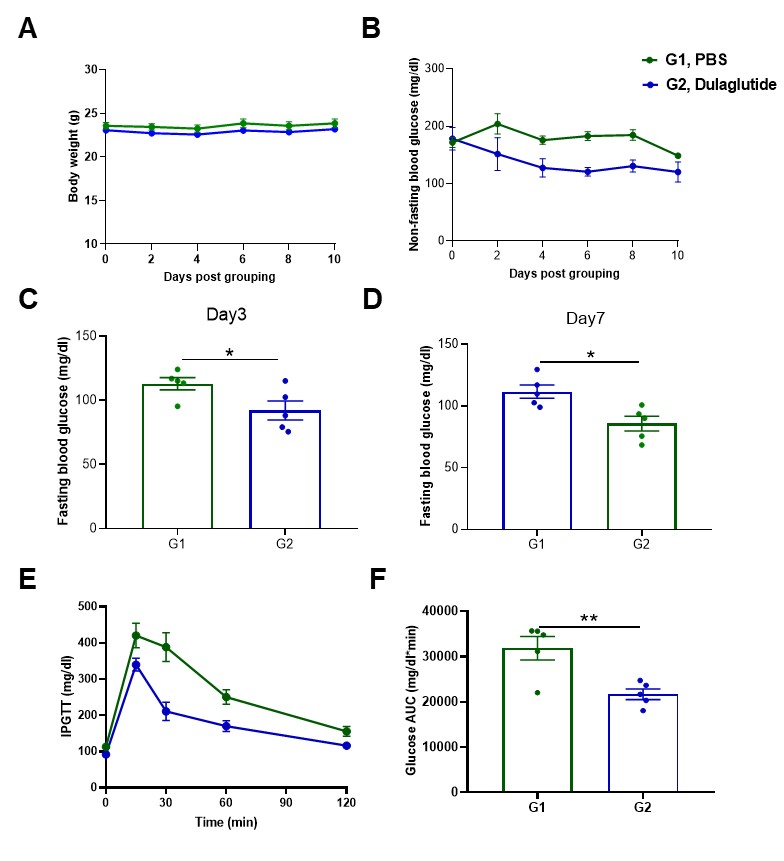
In vivo efficacy of Dulaglutide in B-hGLP1R mice. B-hGLP1R mice (male, 7-8w, n=5) were grouped by body weight and blood glucose, then treated with Dulaglutide (in house) for 1 mg/kg, Q2D, s.c. (A) Body weight. (B) Non-fasting blood glucose. (C, D) Fasting blood glucose on day3 and day7. (E) The glucose tolerance test for 2g/kg D-Glucose is administered by intraperitoneal injection (IPGTT) on day3. (F) Area under the curve (AUC) for the IPGTT. As shown, body weight did not change during the experiment, but the non-fasting blood glucose and fasting blood glucose level were reduced by Dulaglutide. Meanwhile, the glucose tolerance was improved. Values are expressed as mean ± SEM. Significance was determined by the Unpaired t test. (*P < 0.05, **P < 0.01, ***P < 0.0001)
-
In vivo efficacy of PF-06882961 in B-hGLP1R mice

-
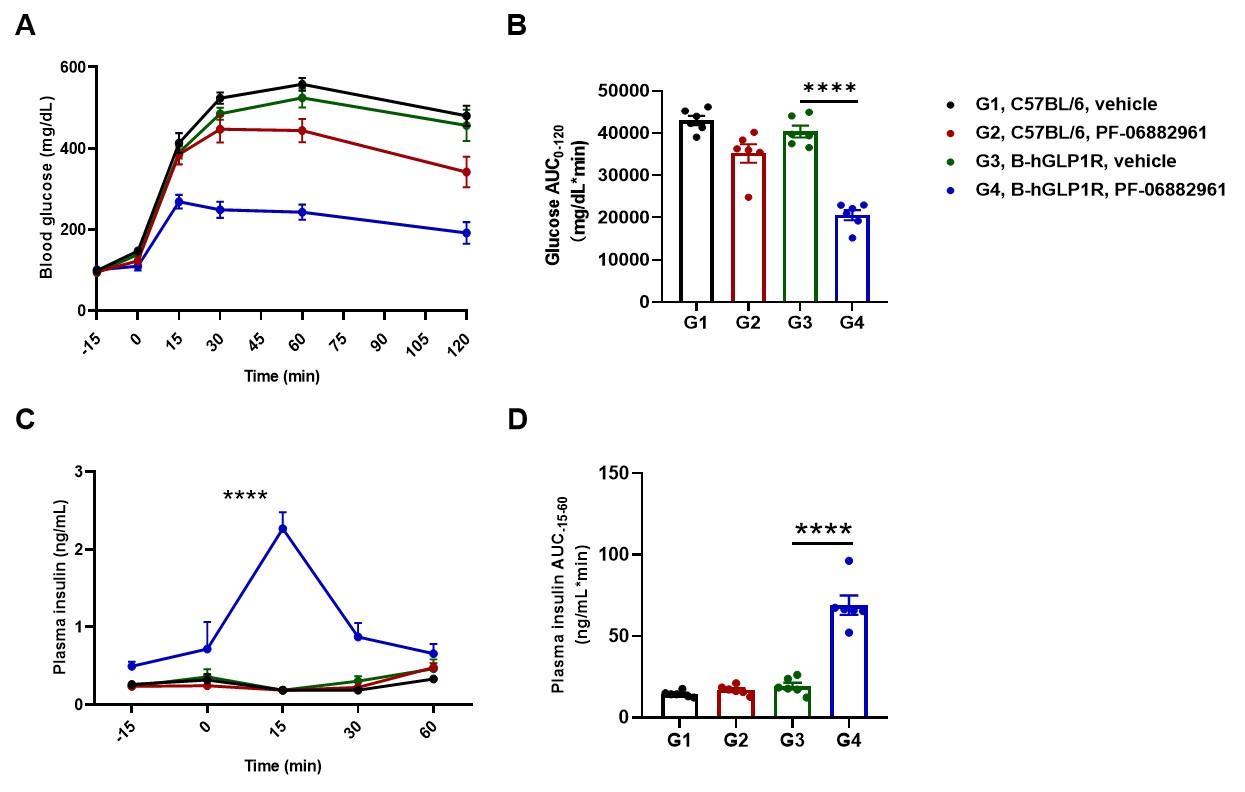
PF-06882961 improved glucose tolerance and promote insulin secretion in B-hGLP1R mice. B-hGLP1R mice were treated with PF-06882961 for 3 mg/kg, s.c. Then the glucose tolerance test was performed in C57BL/6 and B-hGLP1R mice for 2g/kg D-Glucose is administered by intraperitoneal injection (IPGTT). (A) Blood glucose. (B) Area under the curve (AUC) for IPGTT. (C) Plasma insulin. (D) Area under the curve (AUC) for the plasma insulin. As shown, glucose tolerance was improved by PF-06882961 in B-hGLP1R mice but not in wild-type C57BL/6 mice, and promote plasma insulin secretion in B-hGLP-1R mice. Values are expressed as mean ± SEM. Significance was determined by the Unpaired t test. (*P < 0.05, **P < 0.01, ***P < 0.0001)
-
Effect of PF-06882961 and Semaglutide in B-hGLP1R mice food intake

-
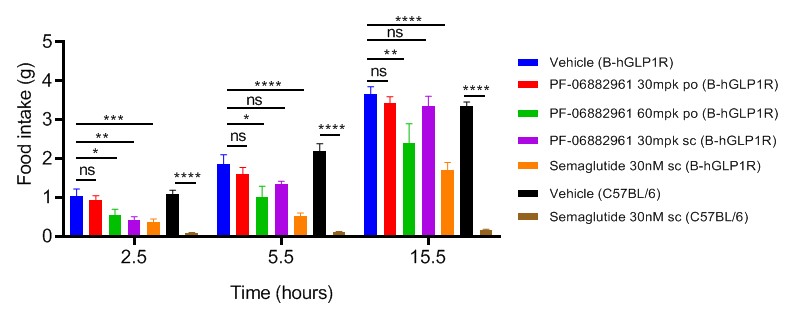
Study of PF-06882961 and Semaglutide in B-hGLP1R mice food intake. B-hGLP1R mice (male, 12-week-old, n=8) were acclimated to handing and oral gavage vehicle for 3 days before study. Mice were grouped by body weight and daily food intake. Subsequently, the mice were treated with dose and route shown in the figure. Food weights were measured on 2.5, 5.5, 15.5 hours after treatment. Values are expressed as mean ± SEM. Significance was determined by the Ordinary one-way ANOVA . (*P < 0.05, **P < 0.01, ***P < 0.0001)
-
In vivo efficacy of Dulaglutide in HFD induced B-hGLP1R mice

-
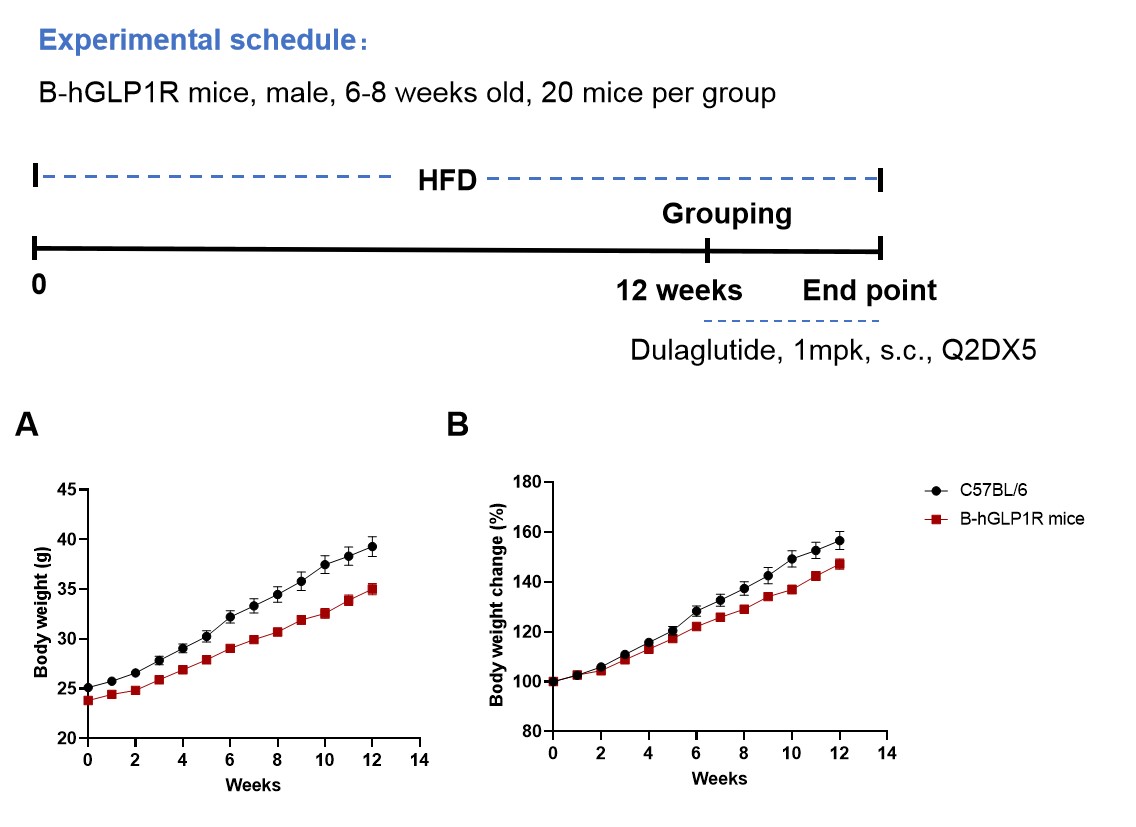
Schedule for HFD induced obesity B-hGLP1R mice. B-hGLP1R mice were fed with a high-fat diet for 12 weeks to induce mice obesity.(A) Body weight and (B) body weight change(%) during the progress. Subsequently, the mice were grouped according to body weight. Then the mice were treated with Dulaglutide (in house). Blood glucose, plasma insulin, and food intake were measured.
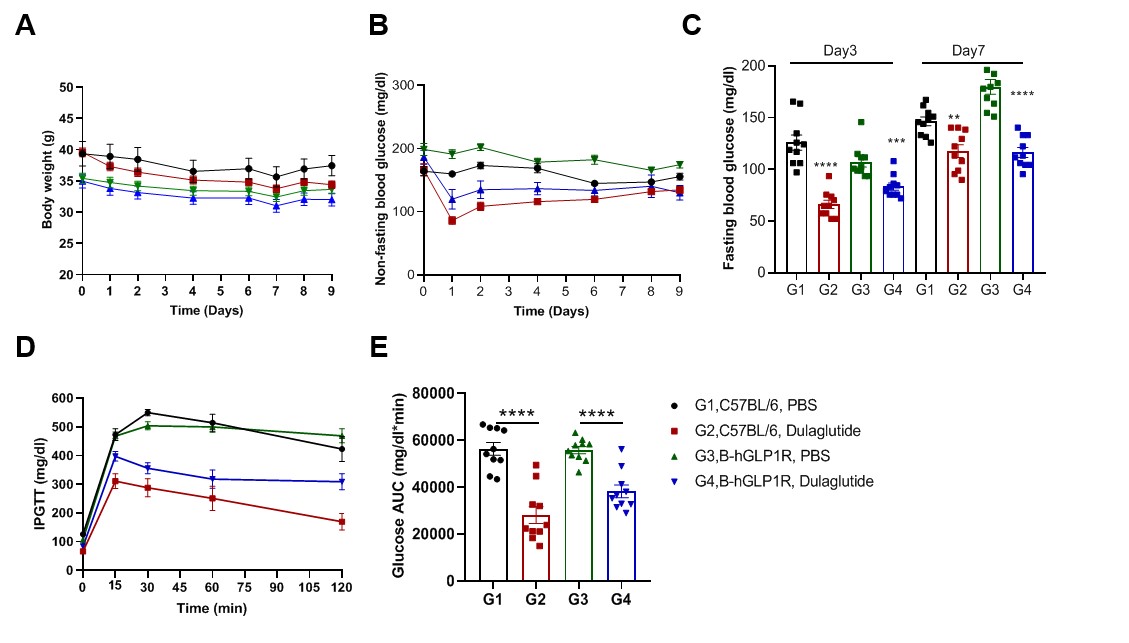
Dulaglutide reduces blood glucose in B-hGLP1R mice. (A) Body weight. (B) Non-fasting blood glucose. (C) Fasting blood glucose. (D) IPGTT. (E) Area under the curve for the IPGTT. As shown, body weight did not change during the experiment, but the non-fasting blood glucose and fasting blood glucose level were reduced by Dulaglutide. Meanwhile, the glucose tolerance was improved. 10 mice per group. Values are expressed as mean ± SEM. Significance was determined by the Unpaired t test. (*P < 0.05, **P < 0.01, ***P < 0.0001)

Dulaglutide regulated blood glucose by increased insulin and decreased glucagon secretion in B-hGLP1R obesity mice, and limited the food intake. (A) Food intake in 24h after treatment. (B) Serum GLP-1. (D) Serum Glucagon. Dulaglutide decreased food intake in C57BL/6 and B-hGLP1R mice, although the decrease was more significant in C57BL/6 mice. Meanwhile, GLP-1 increased and glucagon secretion decreased after treatment with Dulaglutide, which are consistent with the mechanisms of control blood glucose. 10 mice per group. Values are expressed as mean ± SEM. Significance was determined by the Unpaired t test. (*P < 0.05, **P < 0.01, ***P < 0.0001)
-
In vivo efficacy of Semaglutide in HFD induced B-hGLP1R mice

-
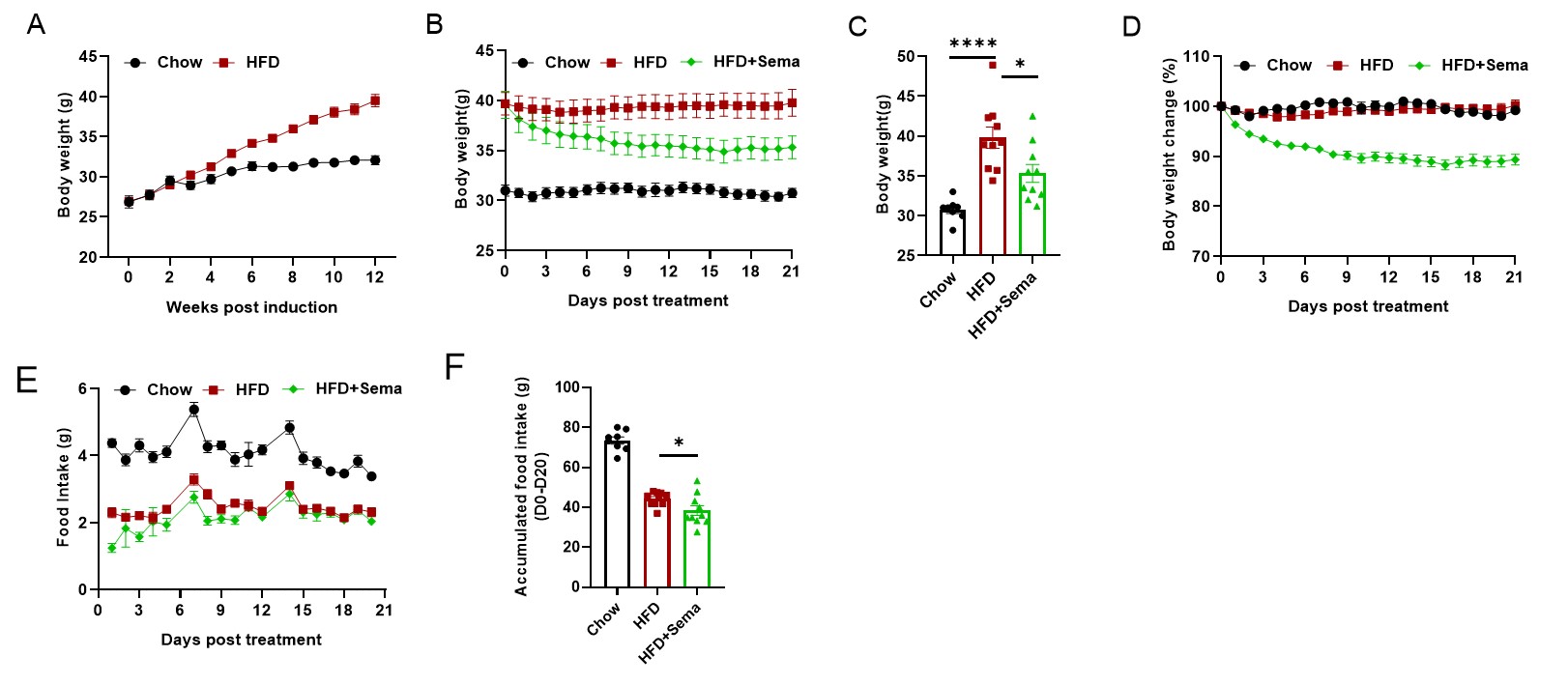
Efficacy study of Semaglutide in HFD induced B-hGLP1R mice. B-hGLP1R mice were fed with a high-fat diet for 12 weeks to induce mice obesity. (A) Body weight change after HFD induction. (B-D) Body weight change after Semaglutide treatment. (E-F) Effect of semaglutide on food intake. 8-10 mice per group. Values are expressed as mean ± SEM. Significance was determined by the Ordinary one-way ANOVA. *p<0.05, **p<0.01,***p<0.001 ,****p<0.0001.

Efficacy study of Semaglutide in HFD induced B-hGLP1R mice. (A) Blood glucose change after Semaglutide treatment. (B) The glucose tolerance test for 2g/kg D-Glucose is administered by intraperitoneal injection (IPGTT). (C) Area under the curve (AUC) for the IPGTT. 8-10 mice per group. Values are expressed as mean ± SEM. Significance was determined by the Ordinary one-way ANOVA. *p<0.05, **p<0.01,***p<0.001 ,****p<0.0001.
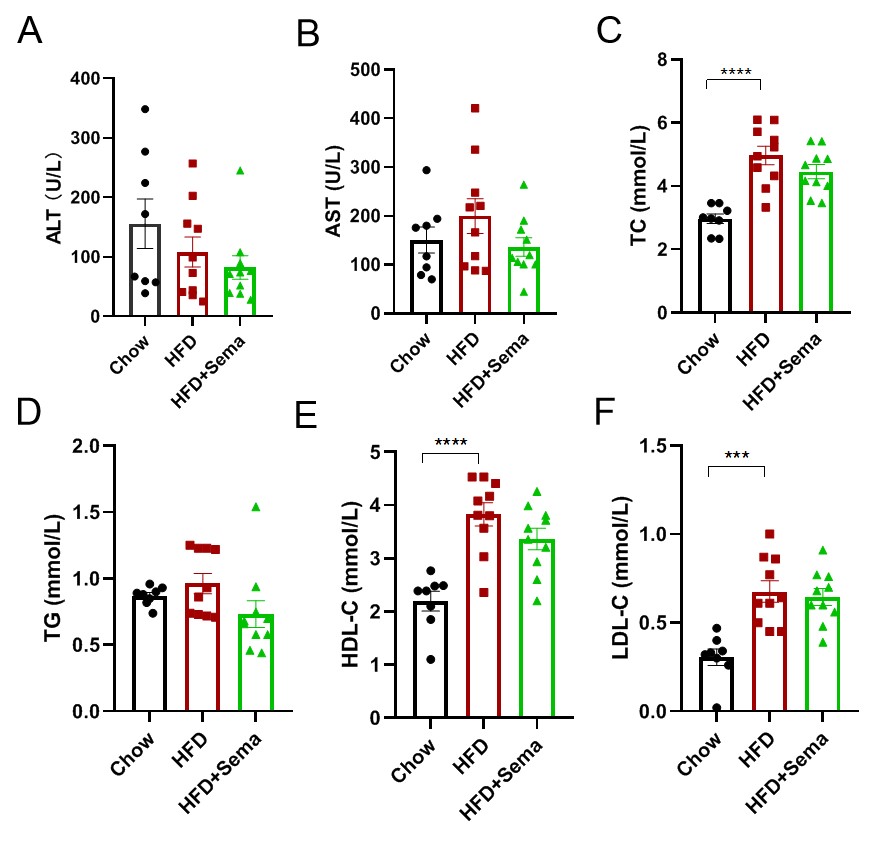
Efficacy study of Semaglutide in HFD induced B-hGLP1R mice. (A-F) Blood biochemical analysis after treatment. 8-10 mice per group. Values are expressed as mean ± SEM. Significance was determined by the Ordinary one-way ANOVA. *p<0.05, **p<0.01, ***p<0.001, ****p<0.0001.
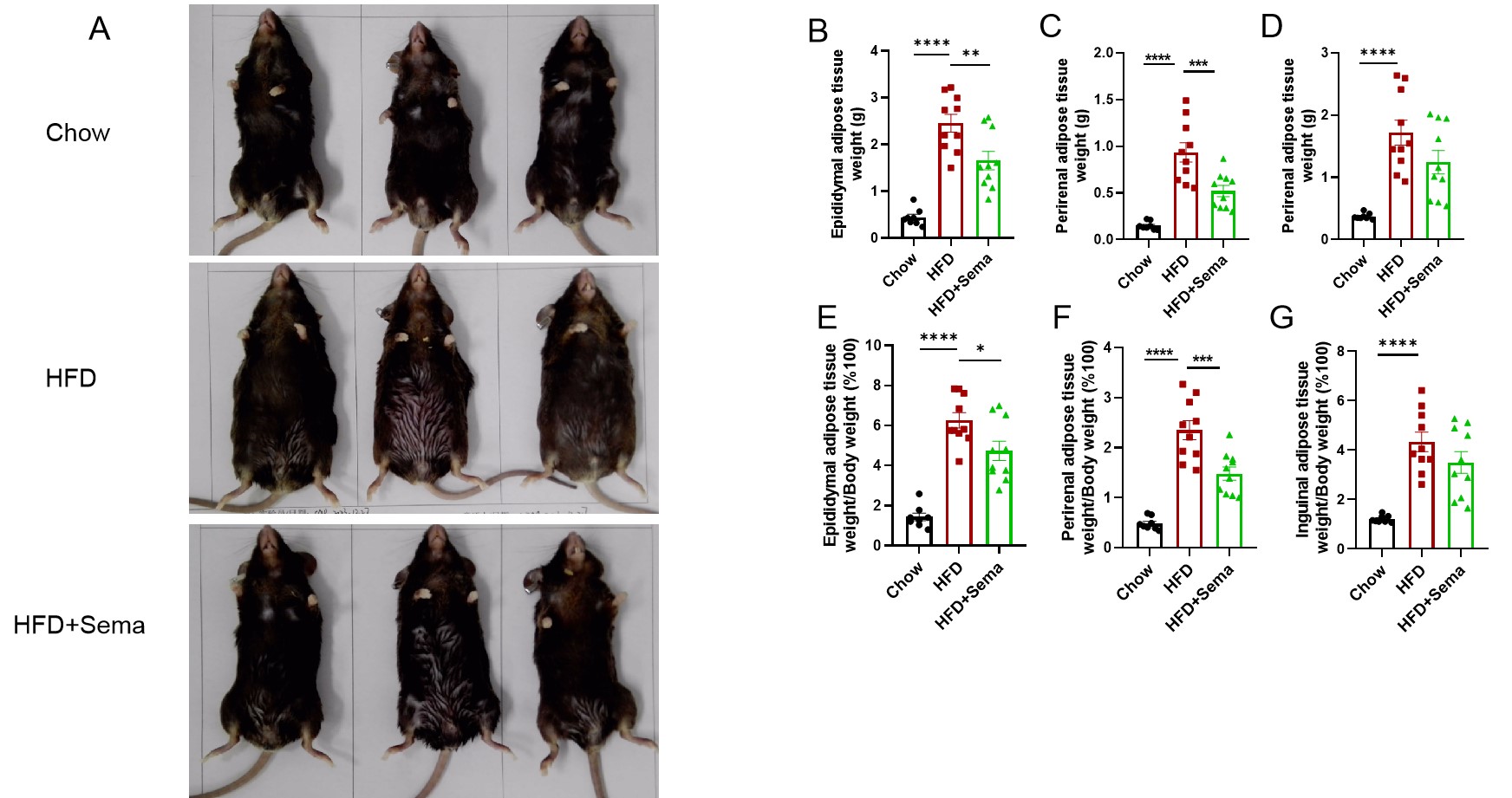
Efficacy study of Semaglutide in HFD induced B-hGLP1R mice.(A) Representative pictures of different groups at termination. (B-D) Adipose tissue weights after treatment. (E-G) Ratios of adipose tissue weight and body weight. 8-10 mice per group. Values are expressed as mean ± SEM. Significance was determined by the Ordinary one-way ANOVA. *p<0.05, **p<0.01, ***p<0.001, ****p<0.0001.
-
Analysis of leukocytes cell subpopulation in B-hGLP1R mice

-

Analysis of spleen leukocyte subpopulations by FACS. Splenocytes were isolated from female C57BL/6 and B-hGLP1R mice (n=3, 9-week-old). Flow cytometry analysis of the splenocytes were performed to assess leukocyte subpopulations. A. Representative FACS plots. Single live cells were gated for the CD45+ population and used for further analysis as indicated here. B. Results of FACS analysis. Percent of T cells, B cells, NK cells, monocytes, dendritic cells, granulocytes and macrophages in homozygous B-hGLP1R mice were similar to those in the C57BL/6 mice, demonstrating that GLP1R humanized does not change the overall development, differentiation or distribution of these cell types in spleen. Values are expressed as mean ± SEM.

Analysis of blood leukocyte subpopulations by FACS. Blood cells were isolated from female C57BL/6 and B-hGLP1R mice (n=3, 9-week-old). Flow cytometry analysis of the blood cells were performed to assess leukocyte subpopulations. A. Representative FACS plots. Single live cells were gated for the CD45+ population and used for further analysis as indicated here. B. Results of FACS analysis. Percent of T cells, B cells, NK cells, monocytes, dendritic cells, granulocytes and macrophages in homozygous B-hGLP1R mice were similar to those in the C57BL/6 mice, demonstrating that GLP1R humanized does not change the overall development, differentiation or distribution of these cell types in blood. Values are expressed as mean ± SEM.

Analysis of lymph node leukocyte subpopulations by FACS. Lymph node were isolated from female C57BL/6 and B-hGLP1R mice (n=3, 9-week-old). Flow cytometry analysis of the lymph node were performed to assess leukocyte subpopulations. A. Representative FACS plots. Single live cells were gated for the CD45+ population and used for further analysis as indicated here. B. Results of FACS analysis. Percent of T cells, B cells and NK cells in homozygous B-hGLP1R mice were similar to those in the C57BL/6 mice, demonstrating that GLP1R humanized does not change the overall development, differentiation or distribution of these cell types in lymph node. Values are expressed as mean ± SEM.


Analysis of T cell subpopulation in spleen, blood and lymph node. The lymphocytes were isolated from spleen, lymph node and blood in C57BL/6 and B-hGLP1R mice (n=3, 9-week-old). The proportion of T cells subpopulation was tested by flow cytometry. There were no differences between C57BL/6 and B-hGLP1R mice, demonstrating that humanized of GLP1R does not change the overall development, differentiation or distribution of these T cell subtypes. Values are expressed as mean ± SEM.
-
Blood chemistry of B-hGLP1R mice

-

Blood chemistry tests of B-hGLP1R mice. Serum from the C57BL/6 and B-hGLP1R mice (n=6, 6-8 week-old) was collected and analyzed for levels of indicators. The measurements of B-hGLP1R mice were similar to that in C57BL/6 mice. Values are expressed as mean ± SEM.
-
Poster



